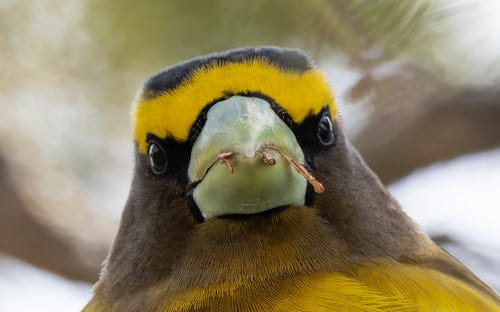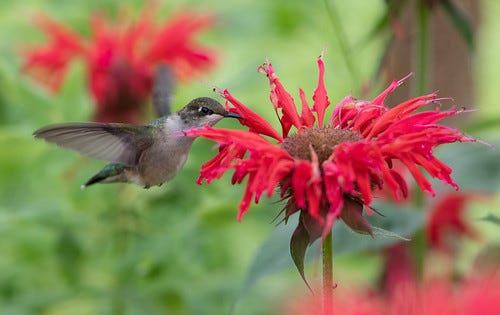(Listen to the radio version here.)
(Every one of the photos in this post, except the one at Hawk Ridge, was taken in my own yard.)
When we bought our house on Peabody Street in 1981, I was pretty sure that I’d see fewer birds here than if we’d moved to my imaginary dream house in the woods. But even though we chose a regular lot in a typical Duluth neighborhood, I’ve seen 27 species of warblers, 7 species of owls, the second and third Rufous Hummingbirds ever seen in St. Louis County…


… and several other notable rarities, like White-winged Dove…
…Red-headed Woodpecker…
…and Summer Tanager, all in my own backyard. Over these four decades, I’ve built up a yard list of 173, which seems pretty darned respectable.
To what do I attribute my good luck? First, of course, is location. Whether birds are following the north shore of Lake Superior in fall or the south shore of Lake Superior in spring, they can’t clear the lake until they reach the tip right here in Duluth. And my neighborhood is directly below Hawk Ridge, the best place for observing the river of migrants in the whole city. I can see streams of raptors, geese, swans, and even the occasional pelicans and cranes flying overhead from my own backyard.

Then there’s the matter of time. I was a stay-at-home mom for two decades, and since then, my writing career has kept me at home a lot. I’ve always kept my desk by a window, so even when I’m working I’m paying attention to birds.
Habitat is critical, too. I was attracted to the house in the first place because of a small cluster of tall white spruces in the backyard that I later discovered had been planted by a little boy as a memorial to his big brother who died in World War I.
The city never finished the street next to our corner lot, leaving a tiny wooded area behind our yard, and the yard itself also had large maples, ashes, box elders, and a couple of mountain ashes, making the house even more alluring.
Those perks didn’t make much of a difference for Russ, but the house was a good size, affordable, and an easy walk or bike ride to his job, the public elementary school, nice grocery and hardware stores, and a post office. I knew I’d be happy here as I carried in the first box on moving day—a Bald Eagle flew overhead to the accompaniment of a chorus of Evening Grosbeaks.

Only one of those World War I-era spruces remains, the ashes just recently died, and the mountain ashes have seen better days—our next project will be to start some new ones. We lost a huge limb off one of the box elders ...

…but the box elder next to our house—the one Russ’s mom warned us had to be taken down “immediately” the first time she visited 43 years ago—is still standing.

Evening Grosbeaks were abundant almost year-round when we moved here. Now most years we don’t see any in Duluth, but when they do show up, they still gravitate to our yard thanks to those box elders waving their seeds like a big “Eat at Joe’s” sign easily seen from above.
We’ve never had the time to do much gardening, but we have done our best to root out invasive thistles and buckthorn, though there’s a tree in a neighboring yard that those neighbors insist on keeping.

Russ loves cherries, so we planted two cherry trees 30 or so years ago. Many birds have enjoyed them, and though they aren’t native, they’re not invasive, either.
One of those trees died in 2021, but before we took it down, chickadees used it for nesting.
Another cherry tree sprouted from the dead one’s roots. Unexpectedly, the cherries on it are just as tasty as on the original, and this tree is still tiny enough that last summer our little grandson Walter could pick a lot of cherries even without Russ holding him up. Limbs have fallen from our surviving cherry tree, and the cherries on most of the remaining branches are too high for Russ to reach, while the tree itself is no longer sturdy enough to brace a ladder against, but that tree will stay there until it topples because so many birds relish it.
Last year Russ planted two new cherry trees in our front yard.
When we moved here, a raspberry bed grew along our side fence. Ten or fifteen years later, the plants suddenly got a fungal disease and died out, but that very year, new ones sprouted up around the cluster of spruce trees, apparently planted by the birds who feasted and then perched in the spruce branches before pooping out the seeds. Those raspberries continue to thrive—wonderful for us and for birds.

We’ve also planted some natives—a couple of juneberry shrubs and one juneberry tree, native thistles, and bee balm.
At some point two or three decades ago, we noticed a nodding trillium in the very back of our yard, and now every spring we see at least a few of them back there.
I tried growing milkweed, but the few times I discovered monarch caterpillars on them, the Minnesota Department of Agriculture’s spraying for spongy moths killed them. The milkweed wasn’t thriving anyway, so I gave up on it.
Dogwoods and woodbine have been growing along our fence since we moved here.
Benign neglect has allowed them to flourish, along with the Brown Thrashers and Gray Catbirds who love nesting in tangles.
My bird feeders lure quite a few birds, of course.

But even more birds are lured in by my birdbaths, especially in late July and August.


We put in a patio in our backyard late last fall, which will be the perfect place for me to watch warblers this year. I bought a 200-800mm lens specifically to get good photos from the patio, though at this point I’ve only been able to test it on robins and a flicker.
I have friends who have gone to great lengths to improve their backyard habitat—friends who put my paltry efforts to shame. I’d be proud to be the kind of person who deserved to get a wildlife habitat designation for my yard, but for the low-energy kind of person I am, I’m extremely happy to be right here on Peabody Street, my home sweet home.

























In 1991 winter, we hadan American Goshawk dive shallowly at the Dark-eyed Juncos, Mourning Doves, Gray Squirrels, Eastern Chipmunks, and Eastern Cottontails at the white proso millet on the ground below the feeder. Once one out of twenty juncos, Slate-colored race, had single white wing bars on each wing, a natural occurrence for this subspecies. Maurice Broun, first curator of Haek Mountain, called Evening Grosbeaks "grospigs" because they consumed so many sunflower seeds.